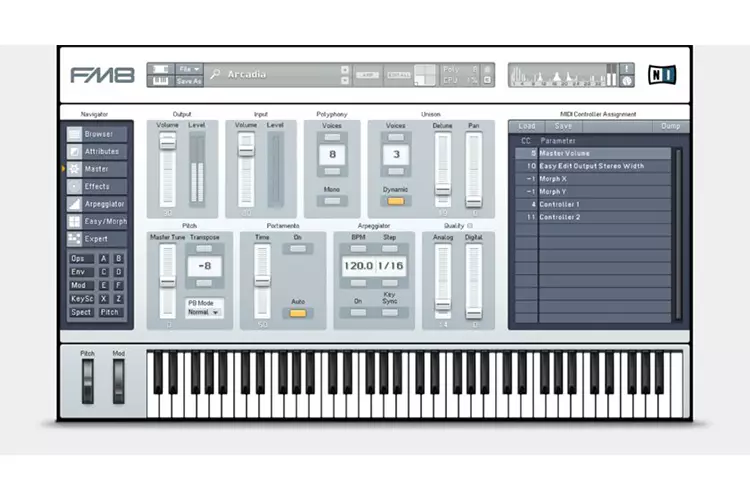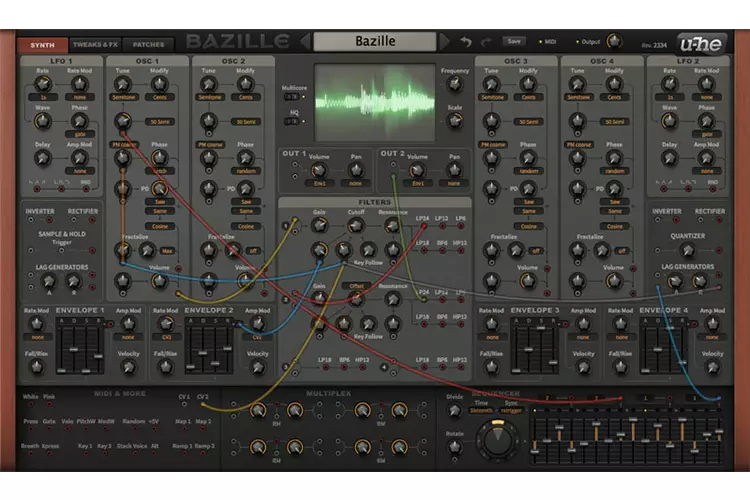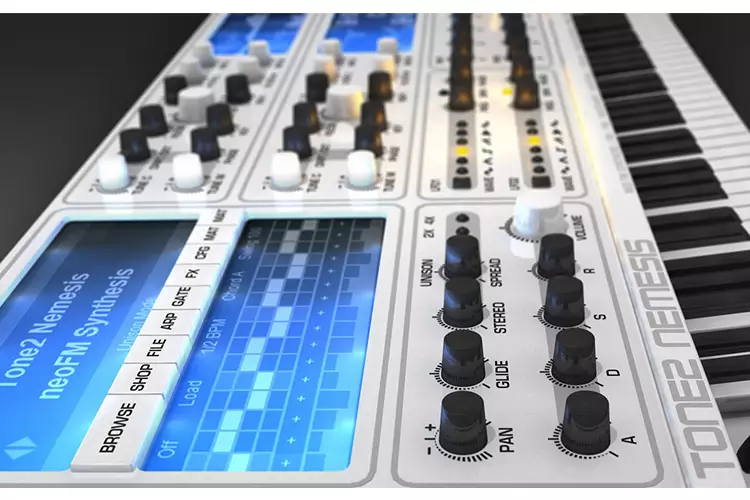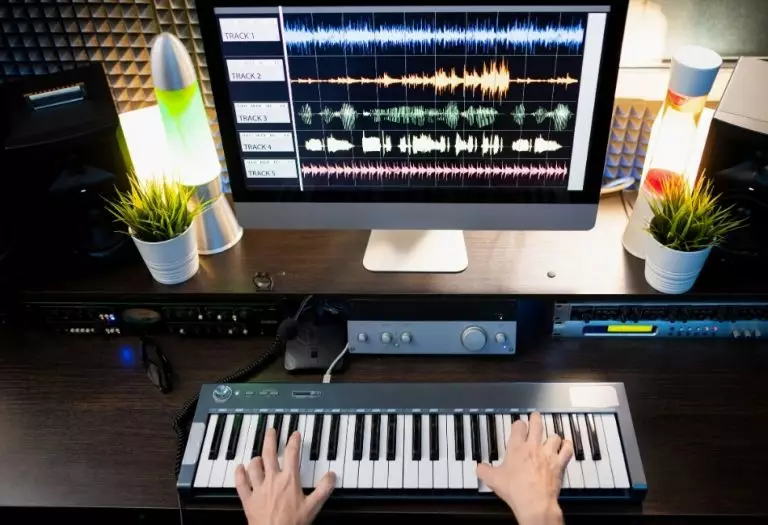Last Updated on January 4, 2024 by IDS Team
Frequency modulators FM synth VST plugins are rapidly gaining popularity among musicians, DJs, and producers alike. Also, people that generally do sound design are much into FM these days.
These little software-based gadgets are devices that can be used to bridge various sonic gaps and obstacles, creating analogue-like sounds from scratch.
It’s only natural for aspiring players and performers to search for the best synths to use, and if so, we’ve got you covered.
Today we’re going to discuss some of the best FM synths on the market, and our latest addition to our list here is a relative newcomer that is often overlooked – the FRMS from Imaginando.
However, we’re championing it because we think it’s one of the most exciting and inventive FM synth vsts out there at the moment.
Apart from that, our list of top picks also now includes Massive X, one of the biggest contenders on the market with both FM capabilities but that also works as a general all round multi purpose synth vst.
So, without further ado, let’s get stuck in:
FM8 FM Synth VST

Native Instruments are among the biggest names in department of software electronics, so it’s quite obvious why we’ve decided to go with their flagship FM8 as our opener pick.
Although pricey, this FM synth program is by far one of the most versatile all-encompassing plugins that this brand has released so far, casting a long shade over its predecessors.
This is a fully digital VST that offers a total of 960 presets, each boasting crystal clear and remarkably authentic FM sounds. Furthermore, this software also packs a robust matrix platform, a dedicated arpeggiator, and well-rounded envelopes.
Although FM8 has its own patches (and downloadable upgrades), it’s also fully compatible with most external FM hardware devices, allowing you to mix and match different setups into a complete, well-rounded one.
The interface of FM8 is straightforward and plain, characterized by slightly oversized knobs and faders, and a 6-octave configurable keyboard.
While it may appear as a beginner producing program, NI’s FM8 is made by professionals for professionals.
FRMS from Imaginando
An unique and lesser-known contender to this list; the FRMS from Imaginando. This synth is really tempting to immediately download on reading about what it does. It’s honestly one of the most alluring synths if you want something fresh to shake up your production. However, what exactly are these features that made us include it?
Ultimate, it’s a combination of granular synthesis, FM, and subtractive synthesis. However, what it lets you do is combine and layer these sounds vis the four synth engines that come with this vst.
As FM synthesis is all about combining sounds from different sources, the idea of combining it with granular synthesis is one that was long overdue. For those not in the know, granular synthesis involves splitting up a sound sample into tiny grains which are then combined to make a waveform.
This creates unique textures that you may not otherwise be able to achieve. And the FRMS allows you to import your own audio files and samples, thus giving it limitless creativity. Essentially, this is a synth all about combining different textures, and blending the color palette of sounds until you have something entirely new.
Specs-wise, each engine has one oscillator that can work in either granular or subtractive synthesis mode. Its FM capacities come from combining these engines, but the uniqueness of the origin sound sources means that the full creative capacities of FM synthesis are here in all their glory.
There ARE some cons, namely that it takes up a huge amount of CPU. But if you want to get a more in-depth look at the FRMS, including its specs, you can take a look at it here on Imaginando’s website and see what else this exciting up and coming developer has to offer.
Ableton Operator Ableton Native Device
The Operator is an integral component of the acclaimed Ableton Suite, and luckily for anyone who’s not using this platform specifically it’s a standalone VST that has only one requirement – Live9 Lite.
It’s substantially cheaper than most VSTs in this category, and it’s also significantly easier to use, mainly because it doesn’t have as many features.
Even though this could be perceived as a con, Operator’s forte is its simplicity.
It features petite, highly customizable sections and is meant as a background plugin that will help you orchestrate different tunes and timbres while working on the tracks simultaneously.
The neat little display takes the centrepiece of the Operator, showing you details regarding the most relevant and important parameters of its performance, such as attack, decay, release, peak, sustain, loop, velocity, waveshape, key, and such.
LFOs and filter sections are modest, to say the very least, but they feature everything you need to come up with unique sonic shapes and tones.
As a matter of fact, these sections can be cut off from the mix in order to preserve some extra CPU and RAM.
Speaking of which, Ableton’s Operator is not as spec-starved as some of its ‘bulkier’ counterparts. It’s not as hard on your computer/laptop’s memory, and you don’t need a fancy, super-strong setup to run it smoothly.
Needless to say, it works best with Ableton’s proprietary gear, but the fact that it’s compatible with external equipment speaks volumes about its versatility.
Bazille FM Synth VST

U-He’s Bazille is, without a shadow of a doubt, one of the strongest performing modular synthesizer VSTs out there.
Before we delve into its capabilities and specs, it’s important to note that it’s compatible with macOS, Linux, and Windows, which is not something many FM synth tools can boast about.
First things first, the versatility of Bazille is practically unparalleled. It boasts two individual LFOs and four separate oscillators, each boasting their own set of configurable parameters and settings.
The oscillators sport multiple gate and semitone modulation knobs, as well as a dedicated ‘Fractalize’ section that you can use to carve out fresh, new tones and sounds.
You’ll also be able to utilize numerous pink & white noise slots, a simplified (and highly responsive) sequencer, four envelopes, and a huge array of highly customizable filters, including gain, spread, resonance, and many others. On top of everything, it’s actually pretty affordable.
Image-Line Sytrus
If you’re mainly working in Fruity Loops Studio (FL Studio), you may want to take a look at Sytrus. This FM synth was developed by Imagine-Line, the same brand that’s ‘responsible’ for one of the finest beginner-friendly DAWs on the market, and it’s actually available for a free preview via your FL software.
Sytrus is an excellent choice even if you’re using other studio tools and platforms.
It’s based on a wonderfully-designed sound engine and sports six user customizable and fully independent operators, frequency modulators, ring modulators, partial-harmonic editors, a massive array of EQ sliders and knobs, and more importantly, a comprehensive Matrix that provides a clear overview of active and passive features.
Furthermore, this VST offers three fully independent filters; speaking of which, there are thirteen types of filters as well as five cutoff-slope features.
Another remarkably interesting feature of the Sytrus is the built-in waveshaper, although most people will probably be more thrilled to utilize the shapes provided by the enormous sample library.
There are a couple of things we didn’t like as much about it, though; namely, it’s slightly harder to use than an average FM synth VST, and some of its features are available exclusively via FL Studio.
Even so, you’ll have to spend quite a bit of time to find a better-rounded frequency modulator for the buck.
Nemesis

Nemesis is Tone2’s creation, and its performance is far beyond formidable.
One of the main reasons why we’ve decided to pull down the curtains with this plugin is that it offers a completely unique NeoFM feature that takes frequency modulation to a completely different level.
A huge number of tones, sounds, and timbres that Nemesis can create are literally unattainable via different software.
Apart from its uniqueness, we also liked most of its more traditional features, such as thousands of patches, top-shelf sound quality, a very intuitive interface, and the sheer fact that it’s incredibly easy to use.
In essence, this VST is wild, exquisite, and much different in comparison to similar plugins. Even though it’s beginner-friendly, you’ll still need some time to get accustomed to the features it comes supplied with.
NATIVE INSTRUMENTS MASSIVE X
And to round up, we couldn’t update this list without mentioning the Native Instruments Massive X. We’ve left it for last because it is one of the best-known and strongest competitors within this niche, however, we have to mention it for the many things that have earned it this popularity in the first place.
For starters, the Massive X is available along with so many other great features from native Instruments. It’s part of the Komplete 14 production bundle, so this synth is often one of the favorites amongst first-time producers looking to get a basic digital studio set up.
In summary, the features that attract so many musicians are as follows:
- Over 170 wavetables and 10 modes of reading them.
- 16 MACRO controls. These essentially allow you to control major parameters such a pitch bending from your DAW. It’s features like this that make Massive X seamlessly integrated with the production process and let it fit into your workflow in a streamlined way.
- Intuitive patching THAT YOU CAN VISUALISE. The challenge in creating an fm synth vt is always to remember that it is an emulation of an instrument that could exist in reality. Thus, is it intuitive and does it work in a way that musicians are actually accustomed to? The Massive X fits all these features.
We actually have an honest review right here, if you want to dig deeper into this revolutionary synth. If you just want to buy it or check the price, the Native Instruments’ website is available by clicking here.
The one downside we think there is to Massive X is that if you’re a seasoned producer, you may want something a little more creative. Sure, it is great and has tons of features, but there are other synths out there that do things more boldy and stimulate and challenge the musician more. That’s why we’ve saved it for last as we feel there are a range of other great fm synth vsts that deserve the spotlight.
To Conclude:
Some of the choices here are obvious, some are less obvious.
What they all have in common is they do something interesting with the capabilities of FM synthesis are provide a creative playground for the music using them.
And if you love getting more news about great software that accurately emulates – and sometimes even goes beyond – the joys of a real-life studio, check out our software section here.






